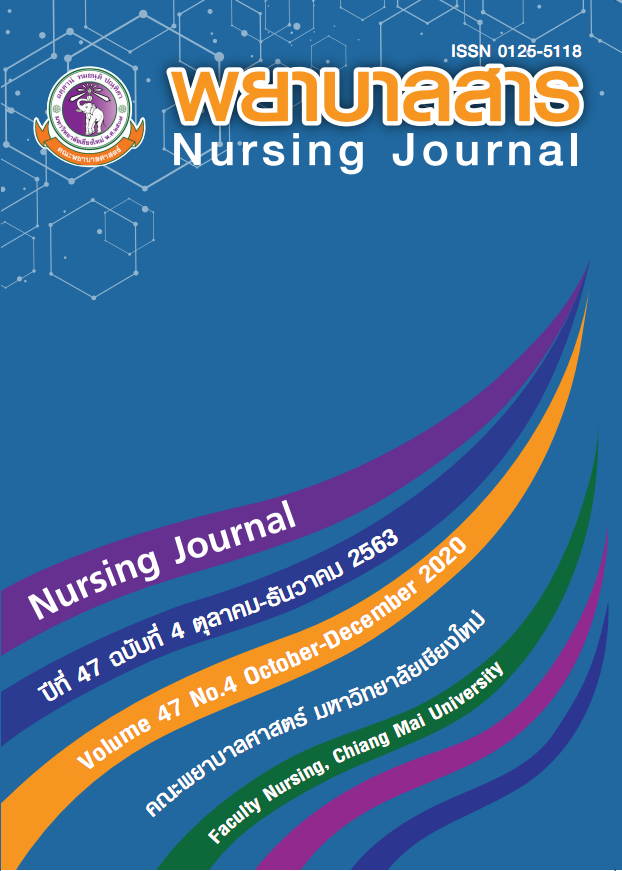Factors Related to Perceived Insufficient Milk Supply Among First-time Mothers with Cesarean Section
Keywords:
Perceived insufficient milk supply, Among first-time mothers, Cesarean sectionAbstract
Breastfeeding benefits all infants, mothers, society, and nation. Insufficient milk supply is a major cause for cessation of breastfeeding. The purpose of this descriptive correlational research study was to explore factors related to perceived insufficient milk supply among first-time mothers with cesarean section which consisted of knowledge of breastfeeding, time to initial breastfeeding, infant breastfeeding behavior and volume of milk transferred. The samples included 85 first-time postpartum mothers who have had a cesarean section and were admitted at the obstetric wards from January to March 2018 at Mukdahan Hospital. The participants were selected on the basis of inclusion criteria. The research instruments consist of 1) the Breastfeeding Knowledge Questionnaire developed by Narinthip Anuntakulnthee (Anuntakulnthee, 2015), 2) the Infant Breastfeeding Assessment tool (IBFAT) developed by Matthews (1988) and modified by Laddawan Chitkow (1999), 3) the Milk Expression Assessment developed by Raweewan Niwattayakul (2005), and 4) the H & H Lactation Scale developed by Hill & Humenick (1996) translated into Thai by Manassawee Srimoragot, Kannika Kantaruksa, & Nonglak Chaloumsuk (2017). Data were analyzed using descriptive statistics, the Pearson’s correlation coefficient, and the Spearman’s correlation coefficient.
Results of the study indicated that almost all of the first-time mothers (96.47%) who have had a cesarean section had knowledge of breastfeeding at a high level, 71.80% initially breastfed for 2-3 hours, 49.40% perceived efficiency of infant breastfeeding behavior at a moderate level, 45.88% had a volume of milk transferred at a moderate level, and 61.20% had a perception of insufficient milk supply at a low level. There was no statistically significant correlation between knowledge of breastfeeding, time to initial breastfeeding of a newborn infant, and infant breastfeeding behavior and the perception of insufficient milk supply. There was no statistically significant correlation between and the perception of an insufficient milk supply.
Based on this study, it could be used as baseline information to encourage first-time mothers who have had a cesarean section to breastfeed successfully.
References
Afrose, L., Banu, B., Ahmed, K. R., & Khanom, K. (2012). Factors associated with knowledge about breastfeeding among female garment workers in Dhaka city. WHO South-East Asia Journal of Public Health, 1(3), 249-255. Retrieved from http://imsear.li.mahidol.ac.th
Albokhary, A. A., & James, J. P. (2014). Does cesarean section have an impact on the successful initiation of breastfeeding in Saudi Arabia? Saudi Medical Journal, 35(11), 1400-1403.
Alden, K. R. (2012). Newborn nutrition and feeding. Maternity & Women’s Health Care (10th ed.). St. Louis: Mosby.
Anuntakulnthee, N. (2015). Factors predicting maternal perception of milk insufficiency in adolescent mothers. Master,s thesis, Mahidol University. (In Thai)
Banu, B., &Khanom, K. (2012). Effects of education level of father and mother on perceptions of breastfeeding. Journal of Enam Medical College, 2(2), 67-73. doi: 10.3329/jemc.v2i2.12840
Bloom, S. L., Spong, C. Y., Weiner, S. J., Landon, M. B., Rouse, D. J., Varner, M. W.,…Gabbe,
S. G. (2005). Complications of anesthesia for cesarean delivery. Obstetrics & Gynecology, 106(2), 281-287. doi: 10.1097/01.AOG.0000171105.39219.55
Cakmak, H., & Kuguoglu, S. (2007). Comparison of the breastfeeding patterns of mothers who delivered their babies per vagina and via cesarean section: An observational study using the LATCH breastfeeding charting system. International Journal of Nursing Studies, 44(1), 1128-1137.
Chisuwan, C., Prasopkittikun, T., Sangperm, P., & Payakkaraung, S. (2012). Predictive power of support from husbands, grandmothers, and nurses on duration of exclusive breastfeeding. Journal of Nursing Science, 30(1), 70-80. (In Thai)
Chitkow, L. (1999). Effects of the administration of narcotic analgesic drug to the mother during the first stage of labor on the behavior and length of time of the first successful breastfeeding among neonates during the early neonatal period. Master,s thesis, Mahidol University. (In Thai)
Department of mental Health. (2016). The twelfth national economic and social development plan (2017-2021). Retrieved form http://www.anamai.moph.go.th (In Thai)
De Silva, M., Senarath, U., Gunatilake, M., & Lokuhetty, D. (2010). Prolonged breastfeeding reduces risk of breast cancer in Sri Lankan women: A case-control study. Cancer Epidemiol, 34(3), 267-273. doi: 10.1016/j.canep.2010.02.012
Hill, P. D., & Humenick, S. S. (1989). Insufficient milk supply. The Journal of Nursing Scholarship, 21(3), 145-148.
Hill, P. D., & Humenick, S. S. (1996). Development of the H & H lactation scale. Nursing Research, 45(3), 136-140. Retrieved from http://ovidsp.tx.ovid.com
Lawrence, R. A., & Lawrence, R. M. (2016). Breastfeeding: A guide for the medical profession (8th ed.). Philadelphia: Mosby.
Lin, S. S., Chien, L. Y., Tai, C. J., & Lee, C. F. (2008). Effectiveness of a prenatal education programme on breastfeeding outcomes in Taiwan. Journal of Clinical Nursing, 17(3), 296-303. doi: 10.1111/j.1365-2702.2006.01927.x
Niwattayakul, R. (2005). Breastfeeding optimization program. In Thai breastfeeding conference proceeding book (pp. 210-214). Bangkok: Research Center for Family Support. (In Thai)
Polit, D. F. (2010). Statistics and data analysis for nursing research(2nded.). Boston: Pearson.
Srimoragot, M. (2017). Factor related to perceived insufficient milk supply among first-time mothers] (Master,s thesis, Chiang Mai University). (In Thai)
Thai Breastfeeding Center Foundation. (2014). The best breastfeeding. Retrieved form http://www.thaibreastfeeding.org/page.php?id=54 (In Thai)
Voramongkol, N., Chetprayuk, I., & Sakulitsariyaphon, S. (2011). Breastfeeding situation in Thailand 2009-2010. Journal of Health Science, 20(5), 721-731. (In Thai)
World Health Organization [WHO]. (2013). Early skin-to-skin contact for mothers and their healthy newborn infants. Retrieved from https://extranet.who.int/rhl/topics/newborn-health/care-newborn-infant/early-skin-skin-contact-mothers-and-their-healthy-newborn-infants
World Health Organization [WHO]. (2015). Breastfeeding. Retrieved form http://www.who.int/mediacentre/infographic/nutrition/breastfeeding.pdf
World Health Organization [WHO]. (2017). Babies and mothers worldwide failed by lack of investment in breastfeeding. Retrieved from http://www.who.int/mediacentre/news/releases/2017/lack-investment-breastfeeding/en/
World Health Organization [WHO]. (2017). 10 facts on breastfeeding. Retrieved form http://www.who.int/features/factfiles/breastfeeding/en/
Downloads
Published
How to Cite
Issue
Section
License
บทความที่ได้รับการตีพิมพ์เป็นลิขสิทธิ์ของวารสารพยาบาลสาร
ข้อความที่ปรากฏในบทความแต่ละเรื่องในวารสารวิชาการเล่มนี้เป็นความคิดเห็นส่วนตัวของผู้เขียนแต่ละท่านไม่เกี่ยวข้องกับมหาวิทยาลัยเชียงใหม่ และคณาจารย์ท่านอื่นๆในมหาวิทยาลัยฯ แต่อย่างใด ความรับผิดชอบองค์ประกอบทั้งหมดของบทความแต่ละเรื่องเป็นของผู้เขียนแต่ละท่าน หากมีความผิดพลาดใด ๆ ผู้เขียนแต่ละท่านจะรับผิดชอบบทความของตนเองแต่ผู้เดียว






